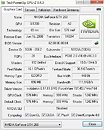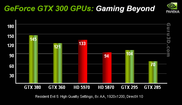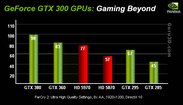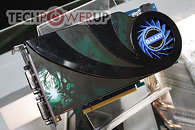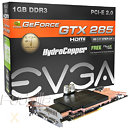Apr 19th, 2025 09:33 EDT
change timezone
Latest GPU Drivers
New Forum Posts
- SK hynix A-Die (Overclocking thread) only for RYZEN AM5 users (67)
- Can Intel recover in DYI market anytime soon? (23)
- Help For XFX RX 590 GME Chinese - Vbios (11)
- Looking for 4060 MXM-A VBIOS (15)
- [Test Build] Fix for 576.02 Driver Install (15)
- Game Soundtracks You Love (1049)
- Axle GTX 1660Ti 6Gb gddr6 bios problem (0)
- Need thoughts on a quiet PC that's great for rendering, video editing and office work... (2)
- RX 9000 series GPU Owners Club (405)
- need help with 12900hx (1)
Popular Reviews
- ASUS GeForce RTX 5060 Ti TUF OC 16 GB Review
- NVIDIA GeForce RTX 5060 Ti PCI-Express x8 Scaling
- ASRock X870E Taichi Lite Review
- Palit GeForce RTX 5060 Ti Infinity 3 16 GB Review
- Teevolution Terra Pro Review
- ASUS GeForce RTX 5060 Ti Prime OC 16 GB Review
- MSI GeForce RTX 5060 Ti Gaming OC 16 GB Review
- Zotac GeForce RTX 5060 Ti AMP 16 GB Review
- MSI GeForce RTX 5060 Ti Gaming Trio OC 16 GB Review
- G.SKILL Trident Z5 NEO RGB DDR5-6000 32 GB CL26 Review - AMD EXPO
Controversial News Posts
- NVIDIA GeForce RTX 5060 Ti 16 GB SKU Likely Launching at $499, According to Supply Chain Leak (182)
- NVIDIA Sends MSRP Numbers to Partners: GeForce RTX 5060 Ti 8 GB at $379, RTX 5060 Ti 16 GB at $429 (127)
- Nintendo Confirms That Switch 2 Joy-Cons Will Not Utilize Hall Effect Stick Technology (105)
- NVIDIA Launches GeForce RTX 5060 Series, Beginning with RTX 5060 Ti This Week (104)
- Over 200,000 Sold Radeon RX 9070 and RX 9070 XT GPUs? AMD Says No Number was Given (100)
- Nintendo Switch 2 Launches June 5 at $449.99 with New Hardware and Games (99)
- Sony Increases the PS5 Pricing in EMEA and ANZ by Around 25 Percent (85)
- NVIDIA PhysX and Flow Made Fully Open-Source (77)
News Posts matching #GTX 285
Return to Keyword BrowsingNVIDIA BIOS Editor (NiBiTor) Version 5.9 Released
NVIDIA BIOS Editor (or NiBiTor), got its timely update, the application is now at version 5.9. NiBiTor allows enthusiasts to extract and manipulate with the VGA BIOS from a supported graphics card. With each new release, the a number of new GPUs are added to the supported products list, bugs fixed, and stability improved. The GPUs added to the list with this release include:
DOWNLOAD: NVIDIA BIOS Editor (NiBiTor) v5.9
- GeForce GTS 450
- GeForce GTS 360M
- GeForce GT 310M
- GeForce GTX 285M
- GeForce GT 240M
DOWNLOAD: NVIDIA BIOS Editor (NiBiTor) v5.9

TechPowerUp GPU-Z 0.4.3 Released
TechPowerUp rolled out a new version of GPU-Z, the popular graphics sub-system diagnostic utility. Version 0.4.3 comes with a load of new features and stability updates. Highlights include full capability to monitor voltages on the GeForce GTX 480, a new method of voltage monitoring which extends support for many ATI and NVIDIA graphics cards, support for the upcoming GeForce GTX 465, GT 320M GT 335M, ION variant, GT 340, Tesla C2050, Tesla M2050, and other Quadro series GPUs, new display languages including Spanish and Hungarian, among other stability updates.DOWNLOAD: GPU-Z 0.4.3
Change log follows.
Change log follows.

NVIDIA Pitches GeForce GTX 300 Series to Clinch Performance Crown
NVIDIA's latest DirectX 11 compliant GPU architecture, codenamed "Fermi," is getting its first consumer graphics (desktop) implementation in the form of the GeForce GTX 300 series. The nomenclature turned from being obvious to clear, with a set of company slides being leaked to the media, carrying the GeForce GTX 300 series names for the two products expected to come out first: GeForce GTX 380, and GeForce GTX 360. The three slides in public domain as of now cover three specific game benchmarks, where the two graphics cards are pitted against AMD's Radeon HD 5870 and Radeon HD 5970, being part of the company's internal tests.
Tests include Resident Evil 5 (HQ settings, 1920x1200, 8x AA, DX10), STALKER Clear Sky (Extreme quality, No AA, 1920 x 1200, DX10), and Far Cry 2 (Ultra High Quality, 1920x1200, 8x AA, DX10). Other GPUs include GeForce GTX 295 and GTX 285 for reference, just so you know how NVIDIA is pitting the two against the Radeon HD 5000 GPUs, given that the figures are already out. With all the three tests, GTX 380 emerged on top, with GTX 360 performing close to the HD 5970. A point to note, however, is that the tests were run at 1920 x 1200, and tests have shown that the higher-end HD 5000 series GPUs, particularly the HD 5970, is made for resolutions higher than 1920 x 1200. AA was also disabled in STALKER Clear Sky. NVIDIA's GeForce GTX 300 will be out in Q1 2010.
Update (12/15): NVIDIA's Director of Public Relations EMEAI told us that these slides are fake, but also "when it's ready it's going to be awesome".
Tests include Resident Evil 5 (HQ settings, 1920x1200, 8x AA, DX10), STALKER Clear Sky (Extreme quality, No AA, 1920 x 1200, DX10), and Far Cry 2 (Ultra High Quality, 1920x1200, 8x AA, DX10). Other GPUs include GeForce GTX 295 and GTX 285 for reference, just so you know how NVIDIA is pitting the two against the Radeon HD 5000 GPUs, given that the figures are already out. With all the three tests, GTX 380 emerged on top, with GTX 360 performing close to the HD 5970. A point to note, however, is that the tests were run at 1920 x 1200, and tests have shown that the higher-end HD 5000 series GPUs, particularly the HD 5970, is made for resolutions higher than 1920 x 1200. AA was also disabled in STALKER Clear Sky. NVIDIA's GeForce GTX 300 will be out in Q1 2010.
Update (12/15): NVIDIA's Director of Public Relations EMEAI told us that these slides are fake, but also "when it's ready it's going to be awesome".

EVGA Precision and GPU Voltage Tuner Updated
EVGA released timely updates to two of its frontline performance control software utilities, the Precision overclocking and monitoring tool, and GPU Voltage Tuner. Version 1.8.1 of the EVGA Precision adds support for newer NVIDIA GPUs, an updated OSD component, among other interface updates that enhance usability. The following are details as listed by EVGA:
- Added NVIDIA GeForce G210, GT220 and GT240 series graphics cards support.
- EVGA On-Screen Display Server has been updated to version 3.5.0. Floating injection address hooking technology, which has been introduced in the previous version, is now disabled by default and can be enabled via the "Stealth mode" option in the server's properties.
- Added hotkeys cross-links checking, Precision no longer allows defining the same hotkey for two different actions at the same time.
- Added "Browse" button to "Screen capture" tab to allow users to change target folder for screenshots.
- Added inegration with external overclocking stability testing applications.

Galaxy shows 9800 GT with mini-HDMI connector
We saw an interesting graphics card at Galaxy today. Their latest
9800 GT uses a mini-HDMI connector instead of a normal sized one.
9800 GT uses a mini-HDMI connector instead of a normal sized one.

More pictures of ASUS Mars 295 Limited Edition: Dual GeForce GTX 285 4 GB
As you probably remember, we reported first on this card last week. Today ASUS has been showing this limited edition card to a public audience for the first time.Also you could see a display that shows how the card is constructed:

Point of View Out With 2 GB GeForce GTX 285
NVIDIA partners seem to be gaining interest in releasing GeForce GTX 200 series products with double the amount of memory. Several partners have announced 1792 MB variants for the GTX 260 and GTX 275, while GTX 285 with its lavish 512-bit memory interface is facilitating 2 GB of memory. Point of View now has one such model of its own.
The card uses reference clock speeds as far as the GPU goes: 648 MHz (core) and 1476 MHz (shader), while going light with its memory, 1161 MHz against the reference speed of 1242 MHz. The rest of the card is pretty standard: 240 shader processors, acceleration for NVIDIA CUDA, and support for PhysX technology, and 3-way SLI support.
The card uses reference clock speeds as far as the GPU goes: 648 MHz (core) and 1476 MHz (shader), while going light with its memory, 1161 MHz against the reference speed of 1242 MHz. The rest of the card is pretty standard: 240 shader processors, acceleration for NVIDIA CUDA, and support for PhysX technology, and 3-way SLI support.

Zotac Expands its GTX 285 Lineup, Uses Accelero Xtreme Cooler
Zotac has yet another GeForce GTX 285 SKU in the making. This time, it plans to use its own-designed GTX 285 PCB with an Arctic Cooling Accelero Xtreme GPU cooler. Zotac isn't using the entire kit, as the NVIO2 and VRM heatsinks aren't compatible with this PCB design. Other manufacturers using this cooler for similar graphics cards include Galaxy, which uses it for its GTX 285 2 GB, and Inno3D, which uses the entire kit for its GTX 280 accelerator.
With the new PCB design, Zotac rearranged the card's VRM area. The design differs from another PCB design for the GTX 285 Zotac designed earlier (read here). The card uses 6 vGPU + 3 vMem power phases. Ferrite-core chokes are made use of, and an extra vGPU phase has been added for redundancy and stability (angled chokes next to the power connectors, pictured below). 1 GB memory across a 512-bit interface is present, with the company making use of Hynix N3C 0.77 ns GDDR3 chips. The clock speeds on this card adhere to NVIDIA's specifications: 648/1476/1242 MHz (core/shader/memory). The SKU is almost ready to be announced.
With the new PCB design, Zotac rearranged the card's VRM area. The design differs from another PCB design for the GTX 285 Zotac designed earlier (read here). The card uses 6 vGPU + 3 vMem power phases. Ferrite-core chokes are made use of, and an extra vGPU phase has been added for redundancy and stability (angled chokes next to the power connectors, pictured below). 1 GB memory across a 512-bit interface is present, with the company making use of Hynix N3C 0.77 ns GDDR3 chips. The clock speeds on this card adhere to NVIDIA's specifications: 648/1476/1242 MHz (core/shader/memory). The SKU is almost ready to be announced.
Dongwon Innovates Modular Full-Coverage G200 Series Water-Block
Relatively unknown to the west, yet popular in the Asian OEM and retail markets, Chinese component cooler designer Dongwon has innovated a modular full-coverage design for its water-block which boosts its compatibility. The block serves as a simple answer to NVIDIA's almost ever-changing reference PCB design for its single-GPU GeForce GTX 200 series accelerators. The design allows this water-block to fit the P651 (65 nm GeForce GTX 260 and GTX 280), P654 (first versions of 55 nm GeForce GTX 260 and GTX 285), and the newer P897 PCB design for the 55 nm cards.
The full-coverage block consists of two segments: the main unit which provides coverage for the GPU, the memory and the NVIO2 processor; and the second segment that covers the VRM area. The segment's grooves are designed to cover the LFPAK VRM arrangement on P651 and P654, while it can be detached to allow the rest of the block to be used on the P897. We're not entirely sure if the design concept circled around compatibility with different PCB designs, though it ends up being the block's most useful application. Although the company has seemingly no presence in the western retail channels, one can expect this block to come factory-fitted on graphics cards.
The full-coverage block consists of two segments: the main unit which provides coverage for the GPU, the memory and the NVIO2 processor; and the second segment that covers the VRM area. The segment's grooves are designed to cover the LFPAK VRM arrangement on P651 and P654, while it can be detached to allow the rest of the block to be used on the P897. We're not entirely sure if the design concept circled around compatibility with different PCB designs, though it ends up being the block's most useful application. Although the company has seemingly no presence in the western retail channels, one can expect this block to come factory-fitted on graphics cards.

EVGA HydroCopper GTX 285 Spotted
The guys over at Fudzilla have got hold of a photo showing a watercooled variant of EVGA's GTX 285. The card is said to clock in at 720 MHz on the core, 2.77 GHz effective memory clock and a shader clock of 1,620 MHz. These are the same factory overclocked speeds as the recently released FTW edition of the GTX 285 from EVGA, yet being watercooled the HydroCopper version should perform much cooler. There is currently no word on pricing but the card is expected to ship soon.
Apr 19th, 2025 09:33 EDT
change timezone
Latest GPU Drivers
New Forum Posts
- SK hynix A-Die (Overclocking thread) only for RYZEN AM5 users (67)
- Can Intel recover in DYI market anytime soon? (23)
- Help For XFX RX 590 GME Chinese - Vbios (11)
- Looking for 4060 MXM-A VBIOS (15)
- [Test Build] Fix for 576.02 Driver Install (15)
- Game Soundtracks You Love (1049)
- Axle GTX 1660Ti 6Gb gddr6 bios problem (0)
- Need thoughts on a quiet PC that's great for rendering, video editing and office work... (2)
- RX 9000 series GPU Owners Club (405)
- need help with 12900hx (1)
Popular Reviews
- ASUS GeForce RTX 5060 Ti TUF OC 16 GB Review
- NVIDIA GeForce RTX 5060 Ti PCI-Express x8 Scaling
- ASRock X870E Taichi Lite Review
- Palit GeForce RTX 5060 Ti Infinity 3 16 GB Review
- Teevolution Terra Pro Review
- ASUS GeForce RTX 5060 Ti Prime OC 16 GB Review
- MSI GeForce RTX 5060 Ti Gaming OC 16 GB Review
- Zotac GeForce RTX 5060 Ti AMP 16 GB Review
- MSI GeForce RTX 5060 Ti Gaming Trio OC 16 GB Review
- G.SKILL Trident Z5 NEO RGB DDR5-6000 32 GB CL26 Review - AMD EXPO
Controversial News Posts
- NVIDIA GeForce RTX 5060 Ti 16 GB SKU Likely Launching at $499, According to Supply Chain Leak (182)
- NVIDIA Sends MSRP Numbers to Partners: GeForce RTX 5060 Ti 8 GB at $379, RTX 5060 Ti 16 GB at $429 (127)
- Nintendo Confirms That Switch 2 Joy-Cons Will Not Utilize Hall Effect Stick Technology (105)
- NVIDIA Launches GeForce RTX 5060 Series, Beginning with RTX 5060 Ti This Week (104)
- Over 200,000 Sold Radeon RX 9070 and RX 9070 XT GPUs? AMD Says No Number was Given (100)
- Nintendo Switch 2 Launches June 5 at $449.99 with New Hardware and Games (99)
- Sony Increases the PS5 Pricing in EMEA and ANZ by Around 25 Percent (85)
- NVIDIA PhysX and Flow Made Fully Open-Source (77)
